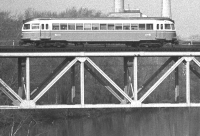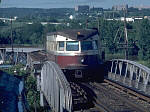
|
This photo of the viaduct, with a Bullet car rolling over it, was taken from the nearby
Dekalb Street bridge in the spring of 1979. Though already almost fifty years old,
the Bullets would soldier on for another ten years. That last decade pushed the limits
of the Bullets and the Strafford cars too far, with several collisions and fires. One
passenger was killed when a Strafford car lost brakes and rammed 69th Street Terminal, ending
up inside the waiting room. The line was almost closed down in the early 1990's, before
used Chicago El cars were brought in, while the new N5 cars were being built.
Mike Szilagyi photo
|
 3D Bullet Car
3D Bullet Car 3D Bullet Car
3D Bullet Car More about the Bullet cars.
More about the Bullet cars.
Return to the main page.